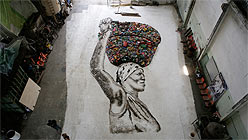Can art affect social change? This is the question put forth by Brazilian artist Vik Muniz in Waste Land, a new film about a community art project he initiated in a “town of garbage.” The location, Jardim Gramacho, is an immense dumping area where “pickers” make a living by collecting and selling recyclable materials from the millions of tons of waste produced by Rio and its suburbs.
Initially, the film was hard to watch. Not because of the footage of piles and piles of trash that would make any consumer’s stomach turn, but because of the artist’s staged conversations about starting the project, which were included in the film for background. Talking to his wife, who asks about the possible dangers of taking up residence in a godforsaken trash town, the dialogue seems almost scripted. Despite the film’s uneasy start, Vik Muniz’s main objective is to make art and to somehow positively affect the garbage pickers’ lives. And he does.
The film follows the artist’s process from project conception to art auction house. He works with a handful of Jardim Gramacho’s resident pickers, whose life stories reflect a range of identities and fates, to create large-scale portraits out of trash to be photographed in his studio. His collaborators include the president of an association that fights for pickers’ rights as part of the recycling industry, two young women you wouldn’t expect to make a living digging through garbage, and an older woman who keeps her pots full of scavenged food to feed her neighbors.




